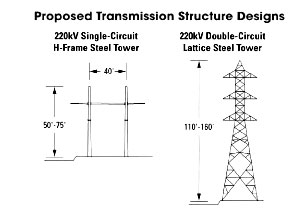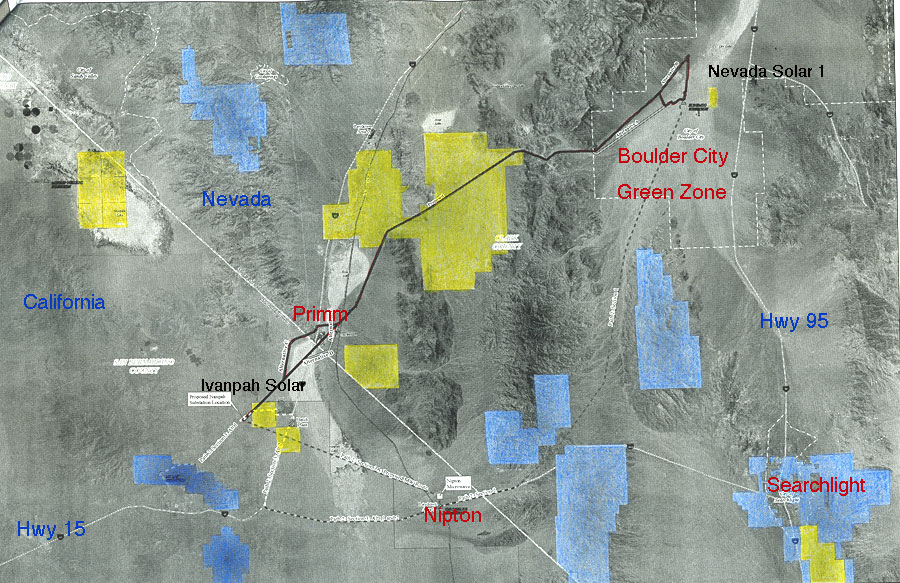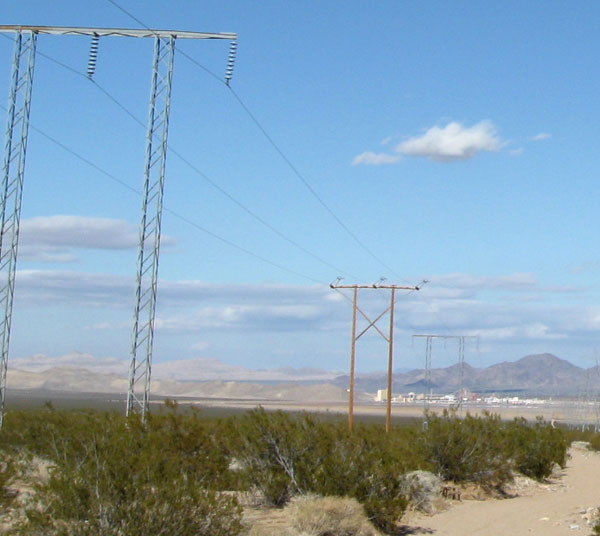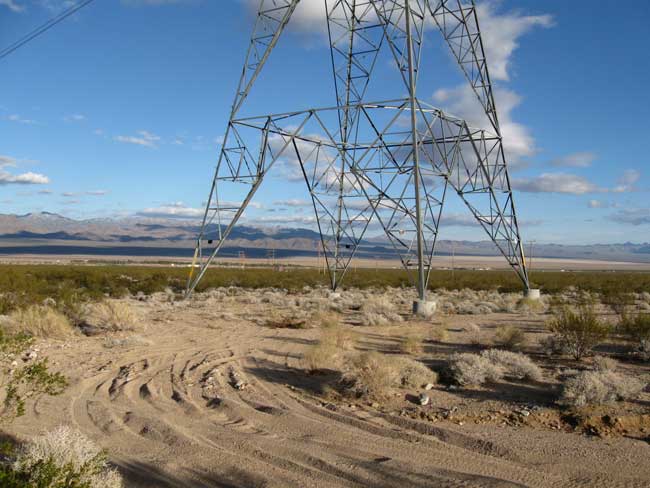BLM Approves Line

^Transmission lines in California's Ivanpah Valley at the site of a proposed giant solar thermal energy plant, with Primm, Nevada in the distance.
The Bureau of Land Management approved a new substation and upgrades to 35 miles of transmission lines near the California-Nevada border that will be used to transfer electricity from energy projects around the Ivanpah Valley to Los Angeles and coastal cities.
http://www.gpo.gov/fdsys/pkg/FR-2011-05-26/html/2011-12992.htm
[Federal Register Volume 76, Number 102 (Thursday, May 26, 2011)]
[Pages 30739-30740]
From the Federal Register Online via the Government Printing Office [www.gpo.gov]
ACTION: Notice of availability.
-----------------------------------------------------------------------
SUMMARY: The Bureau of Land Management (BLM) announces the availability of the Record of Decision (ROD) for the Eldorado Ivanpah Transmission Project (EITP) located in San Bernardino County, California, and Clark County, Nevada. The BLM Needles Field Manager signed the ROD on May 19, 2011, which constitutes the final decision of the BLM.
ADDRESSES: Copies of the ROD have been sent to affected Federal, state, and local government agencies and to other stakeholders and are available at the BLM's Needles Field Office, 1303 South Highway 95, Needles, California 92363 or at the following Web site: http://www.blm.gov/ca/st/en/prog/energy/fasttrack/Eldorado_Ivanpah/fedstatus.html.
FOR FURTHER INFORMATION CONTACT: Tom Hurshman, Project Manager, telephone: (970) 240-5345; address: 2465 South Townsend Avenue, Montrose, Colorado 81401; or e-mail: caeitp@blm.gov. Persons who use a telecommunications device for the deaf may call the Federal Information Relay Service (FIRS) at 1-800-877-8339 to contact the above individual during normal business hours. The FIRS is available 24 hours a day, 7 days a week, to leave a message or question with the above individual. You will receive a reply during normal business hours.
SUPPLEMENTARY INFORMATION: Southern California Edison (SCE) filed an application under Title V of the Federal Land Policy and Management Act (43 U.S.C. 1761) (FLPMA) for a right-of-way (ROW) authorization on BLM managed lands to upgrade and replace an existing 115-kilovolt (kV)
transmission line on public lands with a new double circuit 230-kV transmission line in compliance with FLPMA, BLM Right of Way (ROW) regulations, and other applicable Federal laws. The upgraded
transmission line would extend approximately 35 miles from southern Clark County, Nevada, into northeastern San Bernardino County, California. About 28 miles of the project would be in Nevada and about 7 miles of the project would be in California. The project also includes a new Ivanpah substation in California near Primm, Nevada, which would serve as a connector hub for solar energy generated in the Ivanpah Valley area. A fiber optics telecommunications cable will be located on the new transmission towers and an additional fiber optics pathway ROW is also approved. The EITP ROW grant will impact approximately 480 acres during construction.
The BLM conducted a joint environmental review of EITP with the California Public Utilities Commission (CPUC). A Notice of Availability for a joint Final Environmental Impact Statement (EIS)/Environmental Impact Report (EIR) was published in the Federal Register by the BLM on
December 21, 2010. The CPUC published a final decision on December 27, 2010, approving the Final EIS/EIR Environmentally Preferred Route and issued a Certificate of Public Convenience and Necessity (CPNC). The CPNC included all recommended mitigation measures from the Final EIS/
EIR. The BLM's Preferred Alternative is the same as the CPUC Environmentally Preferred Route and was selected in the ROD. The BLM has adopted all mitigation measures recommended in the Final EIS/EIR. The project area is managed by the BLM in accordance with the California Desert Conservation Area Plan and the Las Vegas Field Office Resource Management Plan. The Preferred Alternative is consistent with the California Desert Conservation Area Plan and the Las Vegas Field
Office Resource Management Plan.
Any party adversely affected by this decision may appeal within 30 days of the date of the ROD pursuant to 43 CFR part 4, subpart E. The appeal should state the specific portions of the decision that are being appealed. The appeal must be filed with the Needles Field Manager at the above listed address. According to regulation, BLM decisions issued under 43 CFR part 2800 are and remain in effect pending appeal (43 CFR 2801.10(b)). Please consult the appropriate regulations (43 CFR part 4, subpart E) for further requirements.
See also http://www.desertdispatch.com/news/transmission-10947-california-around.html
Final Environmental Review Statement Out
December 21, 2010 - Although there are no requirements for public comments on a final environmental review document, we encourage you to send them in anyway. Interestingly, the California Public Utlities Commission is recommending AGAINST this transmission upgrade, due to a lack of need.
On November 15, 2010 CPUC Administrative Law Judge Regina M. DeAngelis, designated as the presiding officer in this case, denied the project in a proposed decision. She wrote, "Southern California Edison Company’s estimated costs for the proposed construction are approximately $306 million plus contingency and other related expenses. The project is not intended to address grid reliability concerns or increased demand. The purpose of the project is to interconnect renewable generation in the Ivanpah Dry Lake Area."
DeAngelis also wrote, "In addition, the costs of the project will increase the already steadily rising costs of transmission and under Pub. Util. Code § 1002(a) and the project will negatively impact undisturbed desert lands and endangered species."
Source: http://docs.cpuc.ca.gov/EFILE/ALT/126420.pdf
BLM is not required to solicit comments on Final Environmental Impact Statements, but they usually make it clear that your comments are welcome. BLM has made this confusing on their announcements for the FEIS. The ElDorado-Ivanpah transmission project will create a cumulative scenario that could result in the removal of tens of thousands of acres of old growth desert. The comment info is here:
http://www.cpuc.ca.gov/environment/info/ene/ivanpah/feir-eis/00_2_dear_reader.pdf
Send Comments Here: Letters supporting the No Action Alternative can be sent to BLM here:
George R. Meckfessel
Bureau of Land Management
Needles Field Office
1303 S. Hwy 95
Needles, CA 92363
Fax: 760-326-7099
e-mail: caeitp@blm.gov
................................................................................................
Federal Register: December 21, 2010 (Volume 75, Number 244)
From the Federal Register Online via GPO Access [wais.access.gpo.gov]
DEPARTMENT OF THE INTERIOR
Bureau of Land Management
Notice of Availability of the Final Environmental Impact Report/Final Environmental Impact Statement for the Southern California Edison Eldorado-Ivanpah Transmission Project, California and Nevada.
SUMMARY: In accordance with the National Environmental Policy Act of 1969, as amended, the Federal Land Policy and Management Act of 1976 (FLPMA), and the California Environmental Quality Act of 1970, the Department of the Interior, Bureau of Land Management (BLM) and the California Public Utilities Commission (CPUC) have prepared a Final Environmental Impact Report (EIR)/Final Environmental Impact Statement (EIS) for the proposed Eldorado-Ivanpah Transmission Project (EITP), Clark County, Nevada, and San Bernardino County, California, and by this notice are announcing its availability.
DATES: The BLM will not issue a Record of Decision based on the EITP Final EIR/EIS until 30 days after the date the Environmental Protection Agency publishes its Notice of Availability in the Federal Register.
ADDRESSES: Copies of the EITP Final EIR/EIS are available at the Needles Field Office, 1303 South U.S. Highway 95, Needles, California 92363; on the Internet at: http://www.blm.gov/ca/st/en/fo/needles.html; and at the BLM California State Office, 2800 Cottage Way, Sacramento, California 95825. Electronic (CD-ROM) or paper copies may also be
obtained by contacting George Meckfessel at (760) 326-7000 or by e-mailing your request to caeitp@blm.gov. Please include your name and mailing address.
FOR FURTHER INFORMATION CONTACT: For further information and/or to have your name added to our mailing list, contact Tom Hurshman, Project Manager, address: 2465 South Townsend Avenue, Montrose, Colorado 81401; phone: (970) 240-5345; fax: (970) 240-5368, or e-mail: Tom_Hurshman@blm.gov.
SUPPLEMENTARY INFORMATION: The BLM's purpose and need for the EITP is to respond to Southern California Edison's (SCE) application under Title V of the FLPMA (43 USC 1761) for authorization of a right-of-way (ROW) on BLM-managed lands to upgrade and replace an existing 115-kilovolt (kV) transmission line on public lands with a new double circuit 230-kV transmission line in compliance with FLPMA, BLM's ROW regulations, and other applicable Federal laws. The upgraded transmission line would extend approximately 35 miles from southern
Clark County, Nevada (28 miles), into northeastern San Bernardino County, California (7 miles). The project would also include a new Ivanpah substation in California near Primm, Nevada, which would serve as a connector hub for solar energy generated in the Ivanpah Valley
area. The existing Eldorado Substation would be modified to accommodate the new EITP. The segment of transmission line to be replaced is approximately 36 miles long and originates at the existing Eldorado Substation in T. 25 S., R. 62 E., Sec. 1, Mount Diablo Meridian, and
terminates at the proposed Ivanpah Substation in T. 16 N., R. 14 E., Sec. 4, San Bernardino Meridian.
The BLM will decide whether to approve, approve with modification, or deny issuance of a ROW authorization to SCE for the proposed EITP. The EITP would carry electricity from several renewable energy projects proposed in and around the Ivanpah Valley, including the Ivanpah Solar Energy Generation System currently under construction by BrightSource
Energy Partners. The proposed transmission line and new substation would be constructed within an existing designated utility corridor. Telecommunications lines are also proposed. The public lands in the project area are managed by the BLM in accordance with the California
Desert Conservation Area Plan and the Las Vegas Field Office Resource Management Plan.
The BLM will consider approval of the EITP in a manner that avoids or reduces impacts to public lands. This action is consistent with Federal law and the Department of the Interior's policy to facilitate and encourage the development of renewable energy resources on the
public lands pursuant to Title V of FLPMA and Section 211 of the Energy Policy Act of 2005 (119 Stat. 594, 660). In addition to the proposed action and the no action alternatives,
the Final EIR/EIS analyzes six additional action alternatives that address alternative routes for the transmission and telecommunications lines. As proposed, the transmission line has been sited to take advantage of existing designated ROW corridors which are areas
identified by BLM land use plans as suitable for ROW development. A Notice of Intent to prepare an EIR/EIS for the EITP was published in the Federal Register on July 27, 2009 (74 FR 37053) followed by a 30-day public scoping period. A Notice of Availability for the Draft EIR/EIS was published in the Federal Register on May 7, 2010 (75 FR 25288) followed by a 45-day public comment period. The BLM and the CPUC conducted one public meeting during the comment period on the Draft EIR/EIS. Major comments addressed in this Final EIR/EIS concern project impacts on biological resources, compatibility with the proposed Southern Nevada Supplemental Airport, consistency with existing BLM land use plans, and cumulative impacts.
May 7, 2010 - Bureau of Land Management and California Public Utilities Commission Announce Availability of Draft Joint Environmental Review of Transmission Project in Mojave Desert.
The BLM, along with the California Public Utilities Commission, published a Notice of Availability of a draft joint environmental review on the impacts of a proposed electric transmission line in San Bernardino County, Calif. and Clark County, Nev. Southern California Edison has applied for a right-of-way (ROW) authorization to upgrade and replace approximately 35 miles of an existing 115-kilovolt (kV) transmission line on public lands with a new double circuit 230-kV transmission line. The proposed Eldorado-Ivanpah Transmission Project would handle electricity produced from several renewable energy project proposals in and around the Ivanpah Valley including the Ivanpah Solar Energy Generation System planned by Solar Partners, LLC, and NextLight Silver State photovoltaic project on the Nevada side.
http://www.blm.gov/ca/st/en/info/newsroom/2010/may/eldorado-ivanpah_draft_er.html
March 10, 2009 - Primm, Nevada
We attended an open house run by Southern California Edison Company (SCE), which is proposing to upgrade a transmission line, substation, and communication line in Clark County, southern Nevada, and eastern San Bernardino County, California in order to accomodate future industrial solar and wind energy projects. This would all be on public land under the jursidiction of the Bureau of Land Management (BLM).
A 35-mile stretch of existing 115 kilovolt (kV) powerline would be replaced with a larger 220 kV line, related to the planned 4,000 acre Ivanpah solar thermal development. A new transmission line would have to be built across McCullough Pass in the McCullough Range in Nevada, just south of Sloan Canyon BLM special petroglyph area, to connect with the Boulder City "green zone" where two solar energy plants already exist: Nevada Solar 1 and Sempra photovoltaic plant. Two local natural gas-burning power plants would also be interconnected, Bighorn power plant near Primm, and the Eldorado plant near Boulder City, Nevada.
Banking on the future of California's renewable energy goals, Edison expects their new lines to be able to carry power that can handle three times the capacity of the proposed Ivanpah solar facility. Their brochure says a benefit of the project would be to "enable Nevada to export clean electricity to California."
Although most of the right-of-ways and upgrades are in Nevada, the power from this project will ALL go to California according to Southern California Edison. The entire upgrade is being paid for by California rate payers. The rep from SCE told us that this project alone would make the rates of SCE go up about 5 to 10 cents per power bill per customer. He said that each additional project that would require an upgrade would also add to the power bills.
 All this intermittent wind and solar energy will need more baseload said SCE representatives -- more natural gas-burning power plants will have to be built. Hoover dam will not be able to carry it all, according to an Edison engineer. He told us that there is no way to store wind/solar power yet, only ideas like compressed air, or storing electricity in a giant salt pond like a battery with low gradient, but all these methods will be inefficient and are years away. When asked how many years away this technology for storage could be, he said "I have no idea."
All this intermittent wind and solar energy will need more baseload said SCE representatives -- more natural gas-burning power plants will have to be built. Hoover dam will not be able to carry it all, according to an Edison engineer. He told us that there is no way to store wind/solar power yet, only ideas like compressed air, or storing electricity in a giant salt pond like a battery with low gradient, but all these methods will be inefficient and are years away. When asked how many years away this technology for storage could be, he said "I have no idea."

^The "open house" held by Southern California Edison at Primm, Nevada. People sat at the table on the right to pen comments.

^Map showing the proposed solar thermal (yellow) and wind (blue) projects on the California/Nevada border south of Las Vegas. The dark line is the proposed SCE transmission line upgrade.
Greenhouse Gases Given Off by Powerlines
Southern California Edison says the new transmission lines will "support the reduction of greenhouse gas emissions," according to their leaflet.
But despite the touted lessening of the need for greenhouse gas-spewing coal-burning power plants (but not natural gas-burning plants) and their replacement by renewables, other problems are created. According to the EPA, sulfur hexaflouride (SF6) is the most potent greenhouse gas studied to date, with a global warming impact of 23,900 times CO2, and a much longer lifespan (estimated at 3,200 years, compared to CO2's 50-200 years). Almost all of it is used and emitted in electrical transmission and distribution, with big spikes in emissions during construction of lines. SF6 is used as an insulator in high-voltage (35 kV and above) circuit breakers, switchgear, and other electrical equipment.
The EPA says that "the electric power industry uses a significant percentage of the SF6 produced worldwide each year. Under ideal operating conditions, SF6 would remain entirely contained within the transmission and distribution equipment. However, during real-world equipment operation, maintenance, and SF6 recycling activities, gas is emitted into the atmosphere. Fugitive emissions of SF6 can escape from gas-insulated substations and switchgear through seals, especially from older equipment. It can also be released during equipment installation and when equipment is opened for servicing. In 1998, U.S. emissions of SF6 were estimated at 10 million metric tons of carbon equivalent (MMTCE). A significant percentage of these emissions are attributable to the electric power industry."
The cumulative damage done by SF6 is as yet unknown, but utilities are trying to reduce its release by "voluntary measures" in the utility industry (which has coincided with a steep price hike in SF6), and this has been successful for those companies which volunteered.
In California not much new grid has been built since the 1970s, so even though the voluntary emissions control resulted in dropping overall emissions numbers, one has to consider this huge push for huge new transmission, and how that will create construction-related spikes in emissions, leaks from decommissioning old lines, as well as the ongoing leaks from transformers and insulators.
Currently, the radiative forcing impact of SF6 is small, but it has a significant growth rate, extremely long atmospheric lifetime, and is a strong absorber of infrared radiation, and therefore has the potential to influence climate far into the future, according to the Intergovernmental Panel of Climate Change in 2001.
The San Diego Gas & Electric Company's Sunrise Powerlink Project Draft Environmental Impact Report / Environmental Impact Statement considered SF6 emissions a non-mitigatable adverse impact of the powerline, that would require a minimum of 12 years of the line being used 100% for renewables (impossible) before it could zero out the emissions from the line itself (not counting the emissions from the power plants or lost natural CO2 sinks full of living desert plants). Any renewable power plant that requires a new powerline, it would seem, is going to never recoup the emissions from the powerline itself, not to mention never offsetting any coal or gas after that.
Our point is that we need to raise serious questions about SF6 emissions and how serious (and permanent) they are, and how they are very likely to cancel out or at least GREATLY diminish any global warming reductions from remote renewable power plants. If people are serious about global warming they should not GREATLY increase greenhouse gas emissions while killing our wilderness and better choose the smart solution.

^Existing powerlines at the proposed Ivanpah solar thermal plant, heading towards Primm, Nevada in the distance, and then over the mountains to the Boulder City "green zone."

HOME.....Ivanpah Solar Project.....Searchlight Wind Project.....Nevada Solar 1.....Transmission
